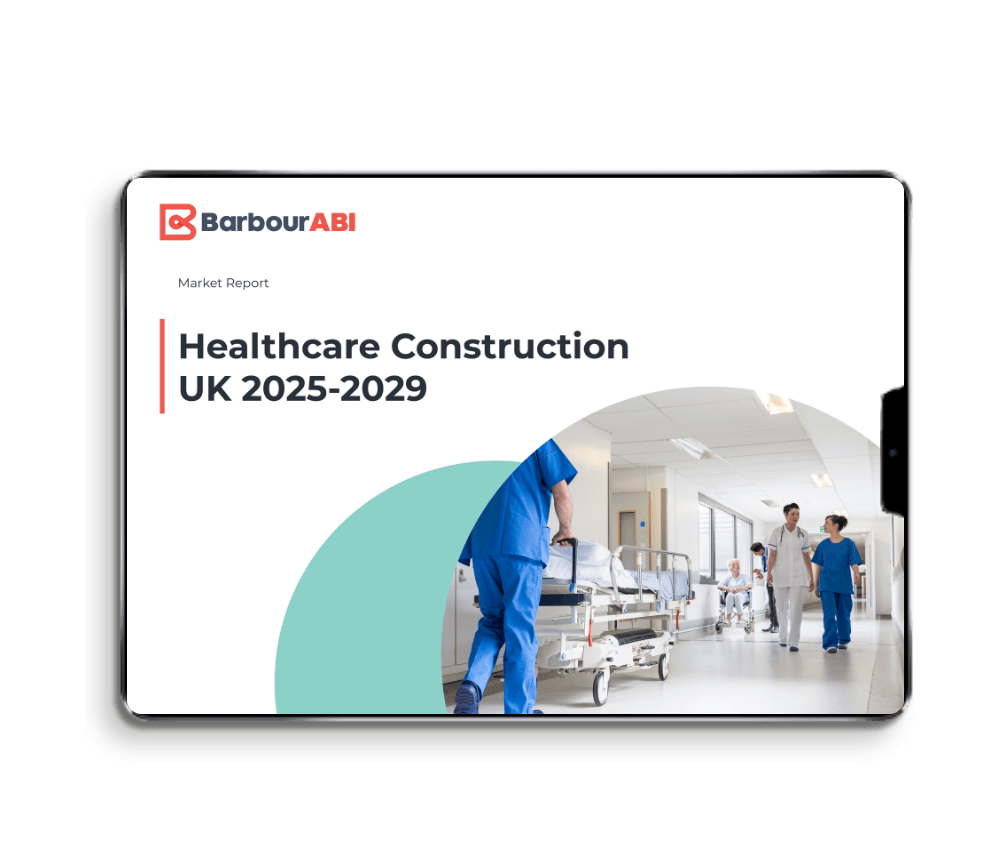Healthcare Construction Market Report – UK 2025-2029
Available as an Instant Download PDF
The 10th edition of the Healthcare Construction Market Report UK 2025–2029 offers a detailed and forward-looking analysis of one of the most strategically important segments of the built environment. This edition tracks the post-pandemic recovery of the sector and provides an in-depth review of public and private healthcare construction output, capital pipeline value, procurement activity, and the shifting policy landscape under the new government.
£1,499.00 Exc. VAT
The UK healthcare construction sector is entering a new phase of investment and reform. Driven by sustained public capital under the New Hospital Programme, targeted infrastructure upgrades, and a growing private health pipeline, the market has rebounded strongly from post-pandemic lows.
Output reached a record £4.04bn in 2023, with continued growth forecast through to 2029. Integrated Care Systems (ICS), digital transformation, modular delivery, and net zero priorities are reshaping both procurement and design strategies. While cost inflation, labour shortages, and policy transition present ongoing challenges, the long-term outlook remains resilient — with the sector playing a central role in modernising the UK’s health estate.
Now in its 10th edition, the UK Healthcare Construction Market Report: 2025–2029 offers a detailed and forward-looking analysis of one of the most strategically important segments of the built environment. This edition tracks the post-pandemic recovery of the sector and provides an in-depth review of public and private healthcare construction output, capital pipeline value, procurement activity, and the shifting policy landscape under the new government.
The report examines the evolving role of Integrated Care Systems (ICS), the long-term trajectory of the New Hospital Programme (NHP), and the increasing capital focus on community-based, digitally enabled, and net-zero compliant healthcare infrastructure. It also highlights the growing influence of private sector investment — particularly in diagnostics, elective care, and care homes — alongside challenges such as labour shortages, inflation, and regulatory reform.
Drawing on Barbour ABI planning intelligence, output data, contract awards, and policy frameworks, the report presents comprehensive market sizing and five-year forecasts. It breaks down regional investment patterns, subsector activity, and profiles the key contractors, clients, and delivery partners shaping the future of UK healthcare estates. With exclusive data and expert commentary, this report is an essential reference for those involved in planning, delivering, or investing in healthcare infrastructure across the UK.
Report Overview
- Market Growth:
The UK healthcare construction market is forecast to grow steadily to 2029, supported by sustained public capital investment and a recovering private sector. - Public Sector Leadership:
Public healthcare schemes represent over 78% of the current pipeline value, with the New Hospital Programme, RAAC remediation works, and NHS capital allocations driving delivery. - Private Sector Resurgence:
Private hospital construction reached its highest level in a decade in 2023, fuelled by demand for diagnostics, self-pay services, and outsourcing of elective care. - Regional Polarisation:
Investment is highly concentrated in London, the Southwest, and Yorkshire & Humber — collectively accounting for over half of all pipeline value. - Post-COVID Recovery:
Output has rebounded strongly, rising by 91% between 2020 and 2023, and surpassing pre-pandemic peaks. - Subsector Trends:
Capital is increasingly directed toward primary care hubs, community health centres, mental health facilities, and diagnostic upgrades — reflecting a shift toward integrated, localised care. - Delivery Models & Policy Influence:
Delivery is evolving under Integrated Care Systems (ICS), with a greater emphasis on modular construction, digital infrastructure, and net-zero design compliance. - Challenges Ahead:
The sector faces constraints from inflation, skills shortages, and complex planning processes — though long-term demand remains strong.
Market Size
The UK healthcare construction market reached a record output of £4.04 billion in 2023, marking a strong recovery from the 2020 pandemic-driven low of £2.12 billion.
Market Analysis
The UK healthcare construction market is undergoing a period of sustained recovery and long-term transformation. Recovery has been largely driven by public capital investment — particularly through the New Hospital Programme (NHP), RAAC remediation works, and devolved Integrated Care Systems (ICS) frameworks.
Public sector projects continue to dominate, making up over 78% of total pipeline value. However, private sector activity is also accelerating with demand being fuelled by NHS outsourcing, diagnostic capacity needs, and growing investment in private hospitals and care homes.
Regional distribution remains uneven, with London, the Southwest, and Yorkshire & Humber accounting for the majority of planned investment.
Looking ahead, the healthcare construction sector is expected to grow at a modest but stable pace. A shift toward modular, net-zero-ready buildings, digital integration, and community-based health hubs reflects evolving care delivery models. Despite challenges, the sector remains a key priority area for capital investment in the UK built environment.
Market Forecast
The UK healthcare construction market is projected to grow at a steady pace through to 2029, underpinned by sustained public investment, a rising private health pipeline, and continued backlog maintenance needs.
Output is expected to increase moderately year-on-year, supported by the delivery of New Hospital Programme schemes, targeted upgrades across the NHS estate, and ongoing investment in care homes, diagnostics, and community facilities.
Key Companies Mentioned in the Report
Kier Group – Active on numerous NHS frameworks, including ProCure23, and involved in large hospital builds and estate upgrades.
BAM Construct UK – Delivering new-build and refurbishment schemes, including modular hospitals and mental health facilities.
ISG – Known for fast-track delivery, particularly in diagnostics centres, hospital upgrades, and fit-out work.
Wates Group – Long-standing healthcare contractor working on NHS Trust frameworks and modular design.
Graham Construction – Key player in acute hospital schemes, mental health developments, and regional ICS projects.
Tilbury Douglas – Formerly Interserve, focused on healthcare refurbishment, RAAC remediation, and surgical hubs.
Laing O’Rourke – Involved in large-scale schemes including modular “Hospital 2.0” concept delivery
- New Hospital Programme (NHP) remains a major driver, with revised timelines and modular delivery focus.
- Integrated Care Systems (ICS) now control local capital decision-making.
- NHS capital spending remains strong, with £4.3bn allocated for 2025–26.
- Policy shift under new government prioritises net zero, digital, and regional equity.
- Private sector investment growing in diagnostics and care homes.
- NHS maintenance backlog exceeds £10bn, fuelling RMI demand.
- Shift toward integrated, localised healthcare delivery.
- Growing use of modular/offsite construction for speed and efficiency.
- Digital infrastructure and smart buildings becoming standard.
- Building Safety Act 2022 increases compliance and accountability.
- All new NHS buildings must meet net-zero standards by 2030.
Regional Analysis
London
- Largest regional pipeline by value, led by major projects such as Hillingdon Hospital (£1.5bn) and Evelina Children’s Hospital extension.
- Strong concentration of both public and private hospital schemes.
- High density, planning complexity, and land values remain key challenges.
Southwest
- Significant capital directed to general hospitals and integrated care hubs.
- Home to one of the largest current schemes: Royal Cornwall Hospital redevelopment.
- Emphasis on mental health and outpatient upgrades within ICS frameworks.
Yorkshire & Humber
- Airedale General and mental health investment form part of a growing regional focus.
- Pipeline reflects a mix of acute, diagnostic and community health schemes.
- Strong public sector commitment tied to levelling-up objectives.
Midlands (East & West)
- Mid-sized pipeline including acute care redevelopments and diagnostics hubs.
- Projects supported by multiple ICSs, including Birmingham and Nottingham.
- Modular delivery growing in regional procurement.
Northwest & Northeast
- Steady pipeline led by ICS integration and RAAC-related rebuilds.
- Backlog maintenance particularly high across legacy NHS estates.
- Regional variation in private healthcare activity (Manchester more active).
Scotland & Wales
- Delivery structured under HubCo (Scotland) and NHS Building for Wales frameworks.
- Projects include mental health, primary care, and refurbishment.
- Planning and funding constraints affect pace of delivery.
Northern Ireland
- Smaller but stable pipeline focused on general hospitals and health centres.
- Centralised procurement via Health Estates Investment Group (HEIG).

Paired Report Discount
Save £250 for every two reports you buy
Discount applied in basket
Frequently bought together
Trusted by industry leaders
For more detailed requests speak to our research experts directly
By using this form you agree that your data will be processed and protected in line with our Privacy Policy.
Research you can depend on
Our reports go deeper to give you the insights needed to make your next strategic move.
- Detailed assessment of the market – analysis of the market structure and recent developments within the market.
- Market prospects up to 4 years – market value, opportunities, impact of socioeconomic events and regulatory developments.
- Detailed information – market size, influences, market factors and key players.
- Analysis by product group – market size, product mix, sector trends etc.



